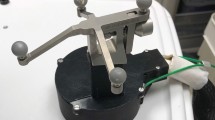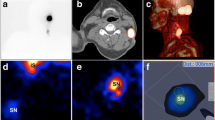Abstract
Purpose
Radioscintigraphic imaging during sentinel lymph node (SLN) mapping could potentially improve localization; however, parallel-hole collimators have certain limitations. In this study, we explored the use of coded aperture (CA) collimators.
Procedures
Equations were derived for the six major dependent variables of CA collimators (i.e., masks) as a function of the ten major independent variables, and an optimized mask was fabricated. After validation, dual-modality CA and near-infrared (NIR) fluorescence SLN mapping were performed in pigs.
Results
Mask optimization required the judicious balance of competing dependent variables, resulting in sensitivity of 0.35%, XY resolution of 2.0 mm, and Z resolution of 4.2 mm at an 11.5-cm field of view. The findings in pigs suggested that NIR fluorescence imaging and CA radioscintigraphy could be complementary, but present difficult technical challenges.
Conclusions
This study lays the foundation for using CA collimation for SLN mapping, and also exposes several problems that require further investigation.




Similar content being viewed by others
References
Fujii H, Kitagawa Y, Kitajima M, Kubo A (2004) Sentinel nodes of malignancies originating in the alimentary tract. Ann Nucl Med 18:1–12
Mertz L, Young NO (1961) Fresnel transformation of images. The International Conference on Optical Instruments and Techniques. Chapman and Hall, London, p 305
Chang L, MacDonald B, Ferez-Mendez V, Shiraishi L (1975) Coded aperture imaging of gamma-rays using multiple pinhole arrays and multiwire proportional chamber detector. IEEE Trans Nucl Sci 22:374–378
Golay MJE (1971) Point arrays having compact, nonredundant autocorrelations. J Opt Soc Am 61:272–273
Fenimore E (1978) Coded aperture imaging: predicted performance of uniformly redundant arrays. Appl Opt 17:3562–3570
Fenimore EE, Cannon TM (1978) Coded aperture imaging with uniformly redundant arrays. Appl Opt 17:337–347
Resinger WW, Rose EA, Keyes JW Jr et al (1981) Tomographic thyroid scintigraphy: comparison with standard pinhole imaging: concise communication. J Nucl Med 22:638–642
Rogers WL, Koral KF, Mayans R et al (1980) Coded-aperture imaging of the heart. J Nucl Med 21:371–378
Accorsi R, Lanza RC (2001) Near-field artifact reduction in planar coded aperture imaging. Appl Opt 40:4697–4705
Accorsi R, Gasparini F, Lanza R (2001) A coded aperture for high-resolution nuclear medicine planar imaging with a conventional Anger camera: experimental results. IEEE Trans Nucl Sci 48:2411–2417
Schellingerhout D, Accorsi R, Mahmood U, Idoine J, Lanza RC, Weissleder R (2002) Coded aperture nuclear scintigraphy: a novel small animal imaging technique. Mol Imaging 1:344–353
Accorsi R (2001) Design of a near-field coded aperture cameras for high-resolution medical and industrial gamma-ray imaging. Ph.D. Thesis: Dept. of Nuclear Engineering, MIT, Cambridge
English JR, Accorsi R, Idoine JD et al (2002) Sub-millimeter technetium-99m calibration sources. Mol Imaging Biol 4:380–384
De Grand AM, Frangioni JV (2003) An operational near-infrared fluorescence imaging system prototype for large animal surgery. Technol Cancer Res Treat 2:553–562
De Grand AM, Lomnes SJ, Lee DS et al (2006) Tissue-like phantoms for near-infrared fluorescence imaging system assessment and the training of surgeons. J Biomed Opt 11:014007
Soltesz EG, Kim S, Kim SW et al (2006) Sentinel lymph node mapping of the gastrointestinal tract by using invisible light. Ann Surg Oncol 13:386–396
Misra P, Lebeche D, Ly H et al (2008) Quantitation of CXCR4 expression in myocardial infarction using 99mTc-labeled SDF-1alpha. J Nucl Med 49:963–969
Ohnishi S, Lomnes SJ, Laurence RG, Gogbashian A, Mariani G, Frangioni JV (2005) Organic alternatives to quantum dots for intraoperative near-infrared fluorescent sentinel lymph node mapping. Mol Imaging 4:172–181
Acknowledgments
We thank Elaine P. Lunsford of the Longwood Small Animal Imaging Facility for the assistance with the image display, Preeti Misra for the preparation of 99mTc-albumin, Hak Soo Choi for the preparation of HSA800, J. Anthony Parker for the many helpful discussions, Mary McCarthy, Lorissa A. Moffitt, and Lindsey Gendall for editing, and Eugenia Trabucchi for the administrative assistance. This work was supported by National Institutes of Health (NIH) grant R01-CA-115296 (JVF) and grants from the Lewis Family Fund (JVF) and the Ellison Foundation (JVF).
Conflict of Interest Statement
Hirofumi Fujii, John D. Idoine, Sylvain Gioux, Roberto Accorsi, David R. Slochower, and Richard C. Lanza do not have any conflict of interest. John V. Frangioni, M.D., Ph.D.: All intellectual property for the FLARE™ and m-FLARE™ imaging systems is owned by the Beth Israel Deaconess Medical Center (BIDMC), a teaching hospital of Harvard Medical School. As the inventor of the technology, Dr. Frangioni may someday receive royalties if the technology is ever commercialized. Dr. Frangioni is the founder and unpaid director of The FLARE Foundation, a non-profit organization focused on promoting the dissemination of medical imaging technology for research and clinical use.
Author information
Authors and Affiliations
Corresponding author
Electronic supplementary material
Below is the link to the electronic supplementary material.
ESM 1
(PDF 3016 kb)
Rights and permissions
About this article
Cite this article
Fujii, H., Idoine, J.D., Gioux, S. et al. Optimization of Coded Aperture Radioscintigraphy for Sentinel Lymph Node Mapping. Mol Imaging Biol 14, 173–182 (2012). https://doi.org/10.1007/s11307-011-0494-2
Published:
Issue Date:
DOI: https://doi.org/10.1007/s11307-011-0494-2




